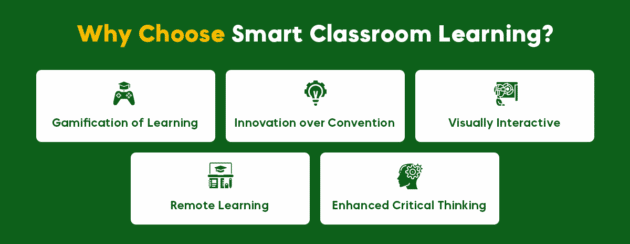Learning and education are critical aspects of human life at every stage. Continuous learning enables people to grow and thrive in the world. As a result, the world is focusing on ways to provide quality learning and education and using it to make economic and evolutionary progress.
Moreover, changing times are calling for a change in the way people perceive learning in general. Owing to the most recent technology advancements, the idea of learning is no longer confined to dull lectures in a four-wall classroom but has expanded drastically. At present, education can be anything a person wants to be, in ways that are unimaginably convenient and smart.
The concept of smart learning isn’t exactly new and has existed for decades. However, it is only with the latest technology innovations and developments that the scope and size of smart education are increasing. This smart education is a key player in promoting smart classrooms, another popular learning concept based on tech-driven innovation. Despite this, many people aren’t aware of the concept of smart classrooms. Therefore, let’s start the blog by understanding what exactly a smart classroom is.
What is a smart classroom?

A smart classroom is a learning space, physical or virtual, driven by technology and technology-based innovation. While the idea of smart classrooms is popular in the education sector, it is worth noting that smart classrooms are more than desktop-turned whiteboards and projectors.
Smart classrooms are a revolution in the learning and education segment and are a complete solution for modern-day learners and educators. To explain, the market worth for smart class and ed-tech was valued at USD 88.82 billion in 2021. These classrooms utilize the latest technologies to illustrate and simplify learning and increase its efficiency. This, in turn, adds to the overall efficiency of the learning process and makes education and learning more fun and interactive.
However, the concept of the smart classroom is highly variable. Different educators utilize smart classrooms in different ways to get the desired results. The upcoming section will discuss the different types of smart classrooms and their uses.
Types of smart classrooms

Recommended for you: The 5 Best Smart Gadgets that Change the Future of Education.
1. Standard smart classrooms
Standard smart classes are the oldest and the most popular forms of classroom learning technology. Generally speaking, the standard smart class setup is based on a projector and whiteboard that are integrated using a computer.
These types of smart classrooms are led by an educator and provide a front-of-the-class learning experience. Moreover, although these types of classrooms are based on minimal technology and are usually simple, they bring numerous benefits to the learners.
The learners can efficiently and easily understand numerous concepts using a standard smart classroom. Moreover, since the type of technology used in these classrooms is fairly simple, there is no additional training required to use the features of these smart classes.
2. Semi-digitalized smart classrooms
These are the type of smart classrooms where educators integrate learning techniques with high-end technologies like Augmented Reality and Virtual Reality. Semi-smart classrooms are highly intelligent and are known to provide a state-of-the-art learning environment to students, owing to the use of advanced technologies.
One of the most popular implementations of VR technology-based classrooms is evident in lab experiments. To explain, practical learning is essential in certain subjects like Chemistry but can be hazardous at times.
In this case, students can use VR-based consoles to conduct experiments virtually in a classroom. Here, the learners can benefit from real-time learning through experiments while eliminating risks and hazards.
3. Self-sustained smart classrooms
Self-sufficient smart classrooms are the most advanced forms of smart classrooms and are highly technology focused. These types of classrooms combine the benefits of software and hardware to deliver top-tier and self-efficient learning solutions.
Self-sustained smart classrooms are the next level of smart education and are the new means to automate learning and education. It is worth noting that these types of smart classrooms are self-sufficient and usually do not require an instructor or an educator.
The primary learning medium in these types of smart classrooms is 1-on-1 learning. Here, every student has access to devices and technologies and learns by exploring and investigating themselves. These types of smart classrooms are ideal for training personnel in investigation and research-based fields like crime investigation and forensic science. Generally speaking, technologies like Metaverse are ideal for this category of smart classrooms. The trainers can provide real-life scenarios on this technology and give a virtual world for the learners to explore by themself.
These were the different types of smart classrooms that are used in the modern world. The type of education that these classrooms deliver is usually on a higher end than conventional classrooms. However, what exactly differentiates the learning outcomes of a smart classroom from a conventional brick-and-mortar classroom? Let’s find the answer to this question in the upcoming section.
What are the characteristics of smart learning?

Gamification of learning
It is commonly known that when learners enjoy the learning process, they tend to achieve the learning objectives in a much easier and more efficient manner. One way to achieve this objective and make the learning process more interesting is to gamify it.
With conventional learning techniques, gamification of learning is often challenging. This is because traditional learning usually involves classroom lectures, which is quite the opposite of what is considered interesting.
On the other hand, smart classrooms are known to integrate interactive learning techniques. Educators can use technology to merge learning outcomes with game-focused learning processes and provide an interesting learning environment. This results in increased attentiveness of the learners and facilitates better learning.
Innovation over convention
Innovation is the driving force for future growth and is becoming a critical factor in helping industries grow. While traditional classrooms are based on conventional learning methods, smart classrooms acknowledge the scope of innovation in learning.
The learning methods used in conventional learning are highly centered on the old and, in many cases, obsolete approaches. Moreover, following these learning techniques often limits the educator’s ability to explain certain concepts. Overall, the idea of education and learning remains confined to book-based education.
On the other hand, the sole purpose of smart classrooms is to bring innovation-driven revolution in learning and education. Learners in smart classrooms utilize top-tier technologies and tech innovations to learn and understand concepts and gain knowledge. Of course, innovation-based learning approaches are more efficient in conveying a point to the learners.
Visually interactive
It is commonly known that the more interactive learning is, the more knowledge the learners tend to retain. One way to increase the rate of knowledge retention among learners is to visualize learning. Visual learning enables learners to thoroughly understand the concept and get the most out of the learning process.
With smart classrooms, students can get a visual representation of different concepts and gain a better, multi-angled perspective. For example, medical students can benefit from smart classrooms and get a detailed and visual experience of human anatomy at any time without having an actual sample to work on. This will enable them to have a better understanding of human functions.
Another example would be a student learning photosynthesis virtually, where smart classrooms can offer a working visual model on the subject along with all the labels. On the contrary, this just isn’t possible with conventional learning or, if possible, would have high cost requirements.
Remote learning
The recent COVID-19 pandemic has made education institutes realize the value of remotely accessible learning. Now that the pandemic has passed, students have the option to visit schools/ colleges and learn traditionally. However, present-day learners and well as educators prefer the online medium more than the traditional one.
Smart classroom technologies enable learners to learn remotely without compromising the efficiency of the learning process. However, this is a factor often missing in conventional learning.
To explain, multinational companies can use smart classrooms to train their employees from the head office remotely. This will enable the companies to save on travel costs, which would otherwise be spent in the case of conventional, in-person training techniques.
Enhanced critical thinking
Smart classrooms enhance the learner’s efficiency in grasping concepts and makes education more interesting and valuable. You must know that smart classroom technologies make a plethora of information available to learners.
On the other hand, traditional methods of learning involve remembering facts and statements, usually in the form of in-class lectures. This learning method is obsolete when compared to smart learning techniques that smart classes facilitate.
Moreover, owing to the high-end audio-visual learning in a smart class, learners tend to develop critical thinking abilities. These critical thinking abilities enable people to solve real-life problems much more easily. This is often challenging to achieve with conventional learning, where the learner’s abilities are limited to books and pictorial diagrams.
These were the characteristics of smart classrooms that differentiate them from conventional classrooms. However, who can benefit from smart classrooms? This question is important for understanding the scope and uses of smart class technologies. Let’s find out the implementations of smart classrooms in the upcoming section.
Who can benefit from a smart classroom?

You may like: Why Web Solutions are Central to Modernize Education Technology?
Students
It is worth knowing that a majority of smart classroom technologies are developed to cater to the needs of school/ university students. Educational institutions integrate smart classes and smart learning technologies with their academic curriculum to deliver a world-class learning experience to students.
The potential of smart classes in the education sector is immense, as smart learning technologies can be used to teach numerous subjects, from Science and Mathematics to languages and others. This proves that the scope of smart classes in the education sector is undeniably high.
Corporates
Learning and development is an essential department in the corporate sector. Focusing on continuous L&D enables corporates to upgrade the skills of their human resources and increase their efficiency. Moreover, this training is even more important for certain businesses to keep the employees’ skills relevant and up-to-date with the industry.
However, conventional training in the form of classroom lectures can often be challenging to provide. To add to that, certain industries require hands-on training, which is a challenge as well when provided conventionally. This is where the scope of smart classrooms comes into the scenario. By utilizing smart classroom technologies, businesses can provide top-tier training to their employees and upgrade their skills.
Whether the purpose of training is to impart new knowledge or teach how to use new machinery or technology to the employees, smart classrooms facilitate overall learning and development virtually through their advanced and interactive learning modes.
Industries
The scope of smart classrooms has far extended learning and education and has reached benefitting industries and increasing their operational efficiency. Smart classrooms have enabled numerous industries like construction and fashion design to increase their operational efficiency and become more efficient.
For example, fashion designers can use smart classrooms to design clothes virtually. These designs are better than pen-and-paper designs and can be used to increase the efficiency of the design process. Another example of smart classroom technologies is evident in the construction industry, where engineers can use smart classrooms to create realistic and 3D construction designs in a working model.
In this way, industries can utilize smart classrooms to improve their work process and enhance their work quality to gain better results. This makes smart classrooms a feasible and worthwhile investment in numerous industries.
We are sure that by now, you are aware of the wide range of applications that smart classrooms have. Now that you are aware of the implementations of smart classrooms, you must know about technologies that facilitate these classrooms. We will cover this topic in the upcoming section.
Technologies that facilitate smart classrooms & smart learning

Hologram
Hologram technology is relatively new but has gained tremendous popularity in recent times. Holograms have made it possible for educators and trainers to conduct learning and education without being physically present in the class. Moreover, holograms make it possible to visualize concepts and illustrate the most complex of diagrams and models in visually understandable 3D models.
As a result, holograms are becoming synonymous with smart classrooms and are becoming an integral part of numerous industries as well as educational institutions.
Learning apps
Learning mobile applications are the most popular form of e-learning technology. Today, learning applications have taken over classrooms and have made them truly smart and intelligent. One of the most popular implementations of learning apps in the smart classroom concept is the replacement of physical books with e-books.
Today, numerous educational institutions have abandoned books and adopted mobile applications. Generally, these e-book apps are used on tablets and other devices that facilitate easy reading.
Moreover, it is also worth noting that out of all the smart classroom technologies, mobile applications have the lowest development time and cost requirement. An app’s development timeline can be as low as two months, while other technologies can take months, or in some cases, even years, to be developed.
Augmented reality / virtual reality
AR/VR is ruling the world in 2022 and is a highly promising form of technology. Virtual Reality is especially useful in smart classroom concepts and has numerous applications. Speaking factually, the market size for VR-based learning technology is expected to reach USD 19.6 billion by 2023. Educators can use VR-based headsets to combine education with virtual learning. These headsets provide a real-like working environment and increase the overall efficiency of the learning process.
Owing to the vast use of VR technology in smart learning, education institutions, corporates as well as numerous industries have been able to significantly cut down on their learning and development costs. This is because VR learning eliminates the cost of resources (that would otherwise be required in conventional learning) without compromising the efficiency of the learning process.
These were the top 3 technologies that promote and facilitate the smart classroom concept. You must identify the potential of each technology in your niche and select the one that meets your requirement.
You may also like: 5 Things Ed-tech Companies Can Learn from BYJU’S Success.
Summing it up

A smart classroom is a million-dollar idea with high potential and the ability to deliver top-tier learning results. Integrating a smart classroom and its technologies can not only increase the overall efficiency of the learning process but can also make learning more fruitful and interesting for learners.
The market scope and potential of the smart classroom concept are immense, making it a popular idea among educational institutions, corporates, as well as industries. All one needs to do is recognize this scope and conduct a well-planned implementation process. This will ensure that you, as well as your learners, get the most out of smart classroom learning.





